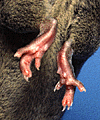Os
Radiation induced Allele Detail
|
|
| Symbol: |
Os |
| Name: |
oligosyndactylism; Os |
| MGI ID: |
MGI:1857646 |
| Gene: |
Os Location: unknown Genetic Position: Chr8, Syntenic
|
| Alliance: |
Os page
|
|
Os/+
Show the 1 phenotype image(s) involving this allele.
|

|
|
|
|
| Allele Type: |
|
Radiation induced |
| Mutation: |
|
Inversion
|
|
|
Os involves 152 genes/genome features (Anapc10, Hhip, Gm5909 ...)
View all
|
| |
|
Mutation details: The oligosyndactylism mutation is due to a chromosomal inversion that has breakpoints approximately 10 Mb apart. One breakpoint appears to reside in the Anapc10 gene, and an aberrant transcript consisting of part of Anapc10 and an unrelated sequence is expressed at low levels.
(J:81567, J:95333)
|
| Inheritance: |
|
Semidominant |
|
|
View phenotypes and curated references for all genotypes (concatenated display).
|
|
|
|
|
|
Heterozygotes are affected on all four feet. Fusion usually occurs between the second and third digits and occasionally involves the fourth (J:13049). The muscles of the forearms and lower legs as well as of the feet show anomalous arrangements not necessarily correlated with the skeletal changes (J:12944). At 11 days of gestation the preaxial border of the limbs can be seen to be reduced (J:12942), and a histological examination at this time shows that there is a small amount of cellular degeneration in the preaxial part of the footplate mesoderm, leading to coalescence of the second and third digital rudiments (J:5107). Os /+ mice have a mild diabetes insipidus present at 5 weeks and increasing with age. In combination with one or more recessive modifying genes in the selected DI stock, Os/+ mice have a severe diabetes insipidus (J:12948). The cause of the diabetes is a 45% reduction in size of the kidneys with an 80% reduction in number of glomeruli. Compensatory hypertrophy of the nephrons is not sufficient to restore normal urine-concentrating ability (J:5127)(J:5128).
|
| Original: |
J:13049 Gruneberg H, Genetical studies on the skeleton of the mouse. XVIII. Three genes for syndactylism. J Genet. 1956;54(1):113-145 |
| All: |
30 reference(s) |
|
 Analysis Tools
Analysis Tools





